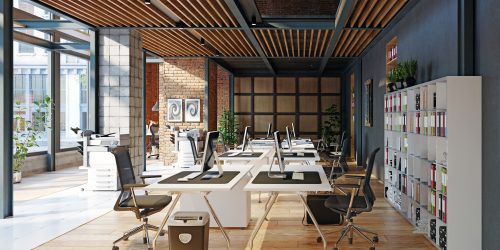What does the ideal working environment look like in 6 key points?
In a constantly changing professional environment, employee well-being has become a major issue for companies. The ideal work environment is one that guarantees both the satisfaction and motivation of employees, while also optimising their productivity. In this article, discover in detail the 6 key points to follow in order to create an ideal work environment, thereby contributing to the well-being of your teams in the company.

1. An ergonomic and comfortable workspace
Comfort and ergonomics are essential factors in creating the ideal work environment. Suitable furniture, such as an ergonomic chair or a height-adjustable desk, helps to prevent musculoskeletal disorders and improves the quality of life at work. Accessories such as footrests, laptop stands, and ergonomic keyboards also help employees maintain a correct posture throughout the day, promoting a comfortable and productive work environment.
The link between well-being and team productivity is undeniable. When someone feels comfortable and at ease in their workspace, their efficiency and concentration are increased. It is therefore essential for companies to take these aspects into account when setting up workstations.
2. Relaxation and conviviality spaces
Creating relaxation and conviviality spaces within the company is also a crucial element in building an ideal work environment. The fika break (Swedish slang for “coffee”), i.e. regular breaks throughout the day (for example, one at 10 a.m. and one at 3 p.m.), allows employees to recharge their batteries and disconnect from work for a second. These moments of relaxation promote cohesion within teams, who can release pressure while stimulating their creativity and productivity.
To set up these relaxation spaces, you can opt for sofas, armchairs, coffee tables, plants, or even games (table football, table tennis, etc.), enabling teams to relax and share convivial moments with colleagues.
3. Lighting and cleanliness of the workplace
An ideal work environment also involves appropriate lighting and impeccable cleanliness of the premises. Adequate lighting (natural light, suitable neon lights, desk lamps) allows for better working conditions, helps prevent eye fatigue, and improves focus.
As for cleanliness and organisation of the workstation, these factors have a direct impact on productivity. An uncluttered and orderly desk helps with focus and saves time by preventing the loss of important objects or documents. The arrangement of convenient and aesthetic storage (shelves, cabinets, drawers) contributes to the creation of an ideal work environment.
4. Customisation of the workspace
Customising the workstation is an essential factor in creating an ideal work environment. It is crucial to allow employees to feel at home by letting the decorate their space with personal items, photos of loved ones, or cherished memories. This personal touch will promote their well-being and involvement in their work, reminding them that they are in a setting tailored to their needs and tastes.
Moreover, customising the work environment can also contribute to strengthening their sense of belonging to the company. Indeed, employees who feel free to customise their professional environment are more inclined to identify with the company culture and share its values. It is therefore important to establish a workstation layout that follows the individual needs of each person while maintaining overall consistency for all teams.

5. The presence of plants and a commitment to sustainability
Integrating plants into the work environment offers many benefits, both aesthetically and psychologically. Plants, whether real or artificial, bring a touch of greenery and colour to the workspace, creating a soothing and pleasant atmosphere. Furthermore, studies suggest that certain plants may improve air quality by reducing the concentration of harmful substances, which is essential for ensuring a healthy environment conducive to concentration.
In addition, a sustainable work environment is also a guarantee of success for the company. By adopting more environmentally friendly practices, such as using recycled materials, waste sorting, and choosing sustainable products, the company demonstrates its commitment to environmental protection. This kind of approach fosters employee motivation and strengthens their adherence to the company’s values while contributing to improving their job satisfaction and well-being at work.
6. A positive work environment and a supportive company culture
To create an ideal work environment, it is essential to establish a positive and supportive company culture. This implies that relationships between colleagues are based on solidarity, mutual support, and communication. A positive work environment promotes employees’ personal growth and enables them to develop their full potential.
Acknowledging employees’ private lives is also vital for establishing an ideal work environment. Flexible working hours, remote working, and taking into account their personal constraints are elements that create an environment that allows a good fit of work-life balance. A caring employer must understand and answer the needs of their employees to ensure optimal working conditions.
An ideal work environment combines comfort, ergonomics, conviviality spaces, cleanliness, customisation, ecological commitment, and a supportive company culture. Crucial to the well-being and productivity of employees, these 6 aspects are the pillars of the work of tomorrow.
To learn more, download our “Future of work” white paper.






